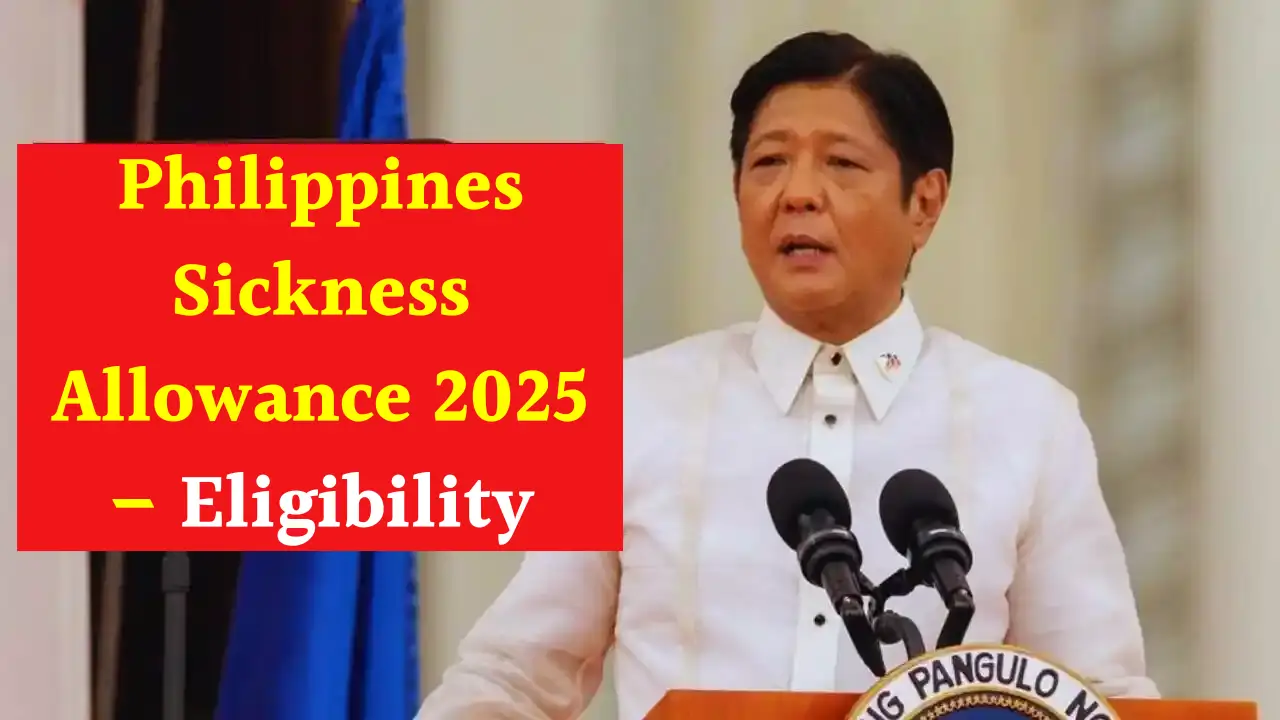The Philippines Sickness Allowance 2025 is one of the most vital social security benefits provided to employees who cannot work due to illness or injury. Managed by the Social Security System (SSS), this allowance ensures that Filipino workers receive financial support during periods when they are unable to earn their normal wages. In 2025, new guidelines, qualifications, and processes have been introduced to make the allowance more accessible and beneficial to workers in both private and informal sectors.
This article covers all aspects of the sickness allowance including eligibility, benefits, application steps, and updated rules for 2025 to help workers in the Philippines fully understand their rights and entitlements.
Overview of Philippines Sickness Allowance 2025
The Sickness Allowance is a cash benefit given daily by the SSS to members who cannot work because of illness, injury, or hospitalization. It is a temporary financial relief designed to replace lost income while the employee recovers.
The allowance is not limited to hospital confinement. It also covers cases of home confinement where medical certification proves the worker must rest and refrain from working. Its main purpose is to prevent employees from falling into financial hardship during medical recovery.
Eligibility Criteria for Sickness Allowance
To qualify for the sickness benefit in 2025, workers must meet specific requirements. These regulations ensure that only eligible SSS members who have contributed to the fund can avail financial assistance.
Key Eligibility Requirements:
- The member must be unable to work due to sickness or injury for a minimum of four consecutive days, either at home or in a hospital.
- The member must have paid at least three monthly SSS contributions in the twelve-month period immediately preceding the sickness or injury.
- Proper filing of notification to the employer (for employed members) or directly to SSS (for voluntary/self-employed members) is required.
- The member must have used all company-paid sick leaves before applying for the SSS allowance.
Updated Benefit Amount Calculation in 2025
The sickness allowance is computed based on the member’s Average Daily Salary Credit (ADSC). As of 2025, the benefit remains set at 90% of the ADSC for each day of approved sickness leave.
The computation ensures that allowance matches the employee’s income bracket and reflects fair daily compensation.
Table: SSS Sickness Allowance Computation 2025
| Average Monthly Salary Credit (AMSC) | Daily Salary Credit | 90% Sickness Allowance per Day | Example Benefit for 10 Days |
|---|---|---|---|
| ₱10,000 | ₱333 | ₱300 | ₱3,000 |
| ₱20,000 | ₱667 | ₱600 | ₱6,000 |
| ₱30,000 | ₱1,000 | ₱900 | ₱9,000 |
| ₱40,000 (maximum cap) | ₱1,333 | ₱1,200 | ₱12,000 |
This table illustrates that the higher the monthly salary credit, the higher the daily allowance benefit an employee receives, but it is capped at the maximum allowed by the SSS.
Duration of Sickness Allowance
As per the 2025 regulations, members can receive sickness benefits for a maximum of 120 days in a calendar year. In cases of extended illness, the benefit period cannot exceed 240 days for the same medical condition.
If the condition lasts beyond 240 days, the sickness allowance stops, and the member may apply for the permanent disability benefit instead. This system ensures that the allowance strictly serves as temporary support.
Filing Sickness Benefit Claims in 2025
The filing process has been streamlined in 2025 with digital channels. Both employed and voluntary/self-employed members can file claims within designated timeframes.
Steps for Employed Members:
- Notify the employer within five calendar days from the start of sickness or injury.
- Employer submits notification to SSS within 30 calendar days.
- Submit medical documents and proof of confinement.
Steps for Voluntary/Self-Employed Members:
- Directly file notification to SSS within five calendar days.
- Provide medical certificates and records.
- Submit valid ID, SSS number, and contribution records.
Late filing may result in denial of claims, emphasizing the need for timely submission.
Employers’ Role in the SSS Sickness Allowance
Employers play a vital role since they act as intermediaries in filing and processing. For employed members, the company must initially cover the daily benefit and then apply for reimbursement from SSS.
Employers’ responsibilities include:
- Submitting accurate sickness notifications to SSS.
- Paying sickness allowance upfront to the employee.
- Maintaining proper records of employees’ absences.
This employer-SSS cooperation ensures smooth flow of financial support to employees.
Impact of Sickness Allowance on Filipino Workers in 2025
The 2025 updates are designed to help workers cope with rising medical costs in the Philippines. With the allowance covering both hospital and home-based confinement, employees do not feel pressured to risk their health by working before full recovery.
In addition, the increased thrust on digitized processes helps simplify access for self-employed members such as freelancers, tricycle drivers, and informal sector workers who are now increasingly contributing to SSS.
Important Notes on Coverage and Exclusions
While the allowance covers most illness and injuries, there are clear exclusions:
- Injuries or sickness resulting from self-inflicted acts.
- Cases where the member fails to comply with filing rules.
- Absences not supported by medical documentation.
Furthermore, the sickness allowance cannot be claimed simultaneously with other similar benefits (like maternity benefit).
Benefits Compared to Other SSS Programs
To better understand its value, it is important to compare the sickness allowance with other SSS cash benefits.
| Type of Benefit | Coverage Period | Amount Basis | Key Purpose |
|---|---|---|---|
| Sickness Allowance | Up to 120 days/year | 90% of daily salary | Temporary health-related work absence |
| Maternity Benefit | 60–105 days | 100% of daily salary | Financial help during childbirth |
| Disability Benefit | Lifetime/extended | Percentage of monthly wage | Permanent or long-term disability |
| Unemployment Benefit | Up to 2 months | 50% of monthly salary | Job loss or retrenchment |
This comparison clarifies how the sickness allowance specifically functions as short-term relief.
Challenges and Improvements Ahead
Despite technological improvements, some challenges remain. Many members face delays in claim approval due to incomplete documents. Others struggle with lack of awareness of updated rules. The government continues promoting digital literacy to encourage workers to utilize online filing systems and avoid visits to SSS branches.
Future improvements may include:
- Faster reimbursement system for employers.
- Expanded maximum daily allowance to match rising wages.
- Integration with PhilHealth for smoother medical financial assistance.
FAQs on Philippines Sickness Allowance 2025
1. How many days can I claim sickness allowance in 2025?
You can claim up to 120 days in a year for sickness or injury.
2. What percentage of my salary do I receive under the sickness benefit?
You will receive 90% of your average daily salary credit.
3. Can I claim sickness benefit if I am self-employed?
Yes, self-employed and voluntary members are now fully covered as long as they meet contribution and filing requirements.
4. What happens if my illness lasts beyond 240 days?
The sickness allowance stops, and you may apply for disability benefits if the condition is long-term.
5. Do I need to use my company’s sick leave before applying for SSS allowance?
Yes, employees must first use all available paid sick leave from their employer before claiming from SSS.
Conclusion
The Philippines Sickness Allowance 2025 is a crucial support system for Filipino workers, offering temporary financial stability during periods of sickness or injury. By ensuring eligibility through proper contributions and timely filing, employees can maximize their benefits. With the push toward digitization and inclusivity for self-employed workers, the SSS sickness allowance continues to provide essential safety nets in a growing and evolving Philippine workforce.












